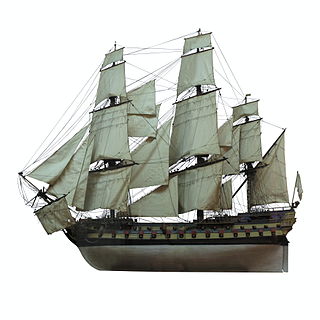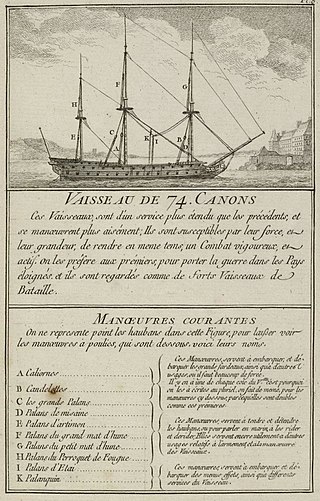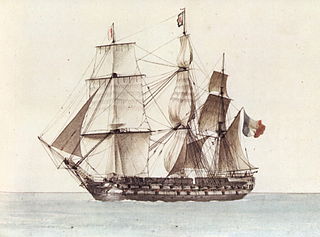
The Battle of Trafalgar was a naval engagement that took place on 21 October 1805 between the British Royal Navy and the combined fleets of the French and Spanish Navies during the War of the Third Coalition of the Napoleonic Wars (1803–1815).

RMS Olympic was a British ocean liner and the lead ship of the White Star Line's trio of Olympic-class liners. Olympic had a career spanning 24 years from 1911 to 1935, in contrast to her short-lived sister ships, Titanic and Britannic. This included service as a troopship during the First World War, which gained her the nickname "Old Reliable", and during which she rammed and sank the U-boat U-103. She returned to civilian service after the war, and served successfully as an ocean liner throughout the 1920s and into the first half of the 1930s, although increased competition, and the slump in trade during the Great Depression after 1930, made her operation increasingly unprofitable. Olympic was withdrawn from service and sold for scrap on 12 April 1935 which was completed in 1937.

An ocean liner is a type of passenger ship primarily used for transportation across seas or oceans. Ocean liners may also carry cargo or mail, and may sometimes be used for other purposes. The Queen Mary 2 is the only ocean liner still in service to this day.

Charles de Gaulle is the flagship of the French Navy. The ship, commissioned in 2001, is the tenth French aircraft carrier, the first French nuclear-powered surface vessel, and the only nuclear-powered carrier completed outside of the United States Navy. She is named after French president and general Charles de Gaulle.

SS Europa, later SS Liberté IMO 5607332, was a German ocean liner built for the Norddeutsche Lloyd line (NDL) to work the transatlantic sea route. Launched in 1928, she and her sister ship, Bremen, were the two most advanced, high-speed steam turbine ocean vessels in their day, with both earning the Blue Riband.

Chevalier Paul is a Horizon-class frigate of the French Marine Nationale commissioned in June 2009, the third vessel of the French Navy named after the 17th century admiral Chevalier Paul. The main mission of this type of ship is the escort and protection of a carrier strike group formed around an aircraft carrier, usually Charles de Gaulle or one of the aircraft carriers of the US Navy, or an amphibious operation carried out by amphibious helicopter carriers. The ship's specialty is air traffic control in a war zone, but it can be employed in a wide variety of missions, such as intelligence-gathering, special forces operations, or in protecting less well-armed vessels. Horizon-class frigates such as Chevalier Paul are the most powerful surface combatants that France has ever built. In service since the end of 2011, it bears the pennant number D621. Its namesake is Jean-Paul de Saumeur, better known as Chevalier Paul, a French naval officer born in Marseille in 1598.

The Redoutable was a Téméraire-class 74-gun ship of the line of the French Navy. She took part in the battles of the French Revolutionary Wars in the Brest squadron, served in the Caribbean in 1803, and duelled with HMS Victory during the Battle of Trafalgar, killing Vice Admiral Horatio Nelson during the action. She sank in the storm that followed the battle.

SS Nomadic is a former tender of the White Star Line, launched on 25 April 1911 at Belfast, that is now on display in Belfast's Titanic Quarter. She was built to transfer passengers and mail to and from the ocean liners RMS Olympic and RMS Titanic. She is the only surviving vessel designed by Thomas Andrews, who also helped design those two ocean liners, and the last White Star Line vessel in existence today.

Mont Blanc was a Téméraire class 74-gun third-rate ship of the line of the French Navy. In the course of her career, she was renamed no less than four times, reflecting the tides of politics with the French Revolution.

Héros was a 74-gun French ship of the line built at Rochefort from 1795 to 1801 by engineer Roland. She was one of the numerous Téméraire class ships designed by Jacques-Noël Sané.

Chantiers de l'Atlantique is a shipyard in Saint-Nazaire, France. It is one of the world's largest shipyards, constructing a wide range of commercial, naval, and passenger ships. It is located near Nantes, at the mouth of the Loire river and the deep waters of the Atlantic, which make the sailing of large ships in and out of the shipyards easy.

Vengeur du Peuple was a 74-gun ship of the line of the French Navy. Funded by a don des vaisseaux donation from the Chamber of Commerce of Marseille, she was launched in 1766 as the Marseillois.

Jean Bart was a Téméraire class 74-gun ship of the line of the French Navy.

Diadème was the lead ship of the Diadème-class 74-gun ship of the line of the French Navy.

Patriote was a Téméraire class 74-gun ship of the line of the French Navy. She was one of the French ships which had their hull doubled with copper.

Commerce de Bordeaux was a Téméraire-class 74-gun ship of the line of the French Navy. She was funded by a don des vaisseaux donation from Bordeaux.

The Conquérant was originally designed and built by François Coulomb the Younger at Toulon from 1745 to 1747, as a modified version of the same constructor's Terrible built at the same dockyard in 1736-40. In need of major repairs by early 1755, she was not employed throughout the Seven Years' War, after which she was formally taken out of service on 17 March 1764 and was rebuilt by Joseph-Louis Ollivier at Brest from January to December 1765 as a Citoyen-class 74-gun ship of the line of the French Navy.

Duquesne was a Téméraire class 74-gun ship of the line of the French Navy. She was captured by the British in 1803, and broken up in 1805.

Léa Hélène Seydoux-Fornier de Clausonne is a French actress. Prolific in both French cinema and Hollywood, she has received various accolades including five César Award nominations, two Lumières Awards, a BAFTA Award nomination, and the Trophée Chopard Award. In 2016, Seydoux was honoured with the Chevalier of the Order of Arts and Letters. In 2022, the French government made her a Knight of the Legion of Honour.

Génois was a Téméraire class 74-gun ship of the line of the French Navy, of the sub-type of Borée and Pluton.




















